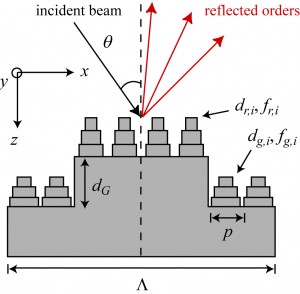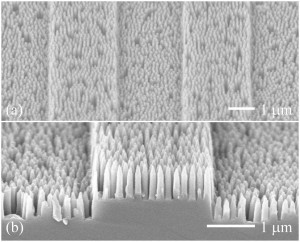Nanostructured Gradient-Index Antireflection Diffractive Optics
- Category: Nanotechnology, Optics & Photonics
- Tags: Chih-Hao Chang, George Barbastathis
In recent years there has been significant interest in broadband, omnidirectional antireflection (AR) nanostructures that minimize Fresnel reflection due to index (impedance) mismatch at an optical interface [1] [2] . The reflection can be suppressed by using adiabatic impedance matching implemented as an intermediate material with gradually varying index in the direction of surface normal. Subwavelength patterning is an effective method to implement such a gradient index (GRIN) surface. However, these recent studies have been mostly restricted to planar surfaces. Diffractive optical elements such as diffraction gratings, Fresnel zone plates, and holographic optics also suffer from Fresnel reflection losses evidenced as undesirable reflection orders. Recently, we proposed a new class of GRIN diffractive optics that is capable of suppressing such reflection losses [3] . Using the same GRIN principles, we can demonstrate diffractive elements where the reflected energy can be suppressed.
The proposed concept of the nanostructured GRIN grating is illustrated in Figure 1, where subwavelength tapered nanostructures with period p are integrated on both the ridge and groove of the grating. Top-view and cross-section micrographs of the fabricated GRIN grating in silicon substrate are depicted in Figure 2. The grating has a period Λ of 5 mm, and the subwavelength cone-shaped pillars have nominal base diameter of 150 nm. The fabricated structure resembles a grating with nano-engineered surfaces. A cross-sectional micrograph is shown in Figure 2(b), where the cone heights on the ridge and groove are 650 and 600 nm, respectively. Some point defects characteristic of nanosphere self-assembly used in the fabrication process can be observed. Broadband characterization of the fabricated structure indicated suppression by at least two orders of magnitude in the reflected orders of the GRIN grating over a large range of incident angles up to 60º.
- Figure 1: Diagram of the proposed GRIN diffraction grating with antireflection nanostructures implemented on the surface. The structure functions by suppressing the reflected diffraction orders.
- Figure 2: (a) Top-view and (b) cross-section scanning electron micrograph of the fabricated GRIN grating with integrated tapered nanostructure on the surface.
- P. Lalanne and G. M. Morris, “Antireflection behavior of silicon subwavelength periodic structures for visible light,” Nanotechnology, vol. 8, pp. 53-56, Oct. 1997. [↩]
- Y. Kanamori, M. Sasaki, and K. Hane, “Broadband antireflection gratings fabricated upon silicon substrates,” Opt. Lett., vol. 24, no. 20, pp. 1422-1424, Oct. 1999. [↩]
- C.-H. Chang, L. Waller, and G. Barbastathis, “Design and optimization of broadband wide-angle antireflection structures for binary diffractive optics,” Opt. Lett., vol. 35, no. 7, pp. 907-909, April 2010. [↩]

